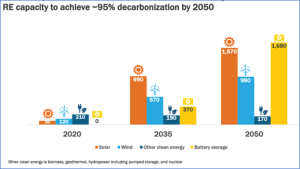ROADMAPS
ARE THERE ROADMAPS FOR THE SMART GRID INFRASTRUCTURE PROJECTS?
In 2015 DOE published a comprehensive roadmap called the Grid Modernization Multi-Year Program Plan (MYPP). It coordinates DOE’s portfolio of activities toward creating a resilient, secure, sustainable, and reliable grid. This roadmap identifies key challenges and opportunities while defining a vision for the modern grid. The MYPP included projections for technical improvements through 2020.[1]
While DOE has yet to update this comprehensive roadmap, the agency has launched several initiatives towards grid modernization.
In December 2020, DOE released its Energy Storage Grand Challenge Roadmap, the department’s first comprehensive energy storage strategy. This roadmap calls for accelerating the transition of storage technologies from the lab to the marketplace, focusing on ways to competitively manufacture technologies at scale in the U.S., and ensuring secure supply chains to enable domestic manufacturing. This Roadmap sets a goal to develop and domestically manufacture energy storage technologies that can meet all U.S. market demands by 2030. Initial focal targets include:
- $0.05/kWh levelized cost of storage for long-duration stationary applications, a 90% reduction from 2020 baseline costs by 2030. Achieving this levelized cost target would facilitate commercial viability for storage across wide a range of uses including:
- Meeting load during periods of peak demand
- Grid preparation for fast charging of electric vehicles
- Applications to ensure reliability of critical infrastructures, including communications
- and information technology.
- $80/kWh manufactured cost for a battery pack by 2030 for a 300-mile range electric vehicle, a 44% reduction from the current cost of $143 per rated kWh.4 Achieving this cost target would lead to cost-competitive electric vehicles.
- Advances in battery production for transportation applications are anticipated to continue benefitting production, performance, and safety of similar technologies used in batteries for stationary applications.[2]
In January 2022, DOE unveiled its new Building a Better Grid Initiative in a Notice of intent entitled Building a Better Grid Initiative To Upgrade and Expand the Nation's Electric Transmission Grid To Support Resilience, Reliability, and Decarbonization, summarized below.
In this notice, the Department of Energy (DOE or the Department) unveils its new Building a Better Grid Initiative focused on catalyzing nationwide development of new and upgraded high-capacity transmission lines. Under the Building a Better Grid Initiative, DOE will identify critical national transmission needs and support the buildout of long-distance, high-voltage transmission facilities that meet those needs through collaborative transmission planning, innovative financing mechanisms, coordinated permitting, and continued transmission related research and development. DOE commits to robust engagement on energy justice and collaboration, including with states, American Indian Tribes and Alaska Natives, industry, unions, local communities, and other stakeholders for successful implementation of the program. [3]
On February 1, 2022, DOE and the Pacific Northwest National Laboratory released their Distribution System Research Roadmap, which summarizes the technical challenges arising from increased distributed energy resource (DER) adoption and evolving load on the electric power distribution system, and then describes a number of research projects expected to yield short-term benefits (within a few years), along with an action plan of next steps to take for DER integration.
In the February 24, 2022 webinar, Tools For Building a Better Grid, Secretary of Energy Jennifer Granholm stated “We actually want to cut emissions in half by 2030, reach 100 percent clean electricity by 2035, and then achieve net zero by 2050.” [4] DOE provided this timeline for expanding renewable energy and developing energy storage technologies in support of the 2050 decarbonization goal:

Source: U.S. Department of Energy [4]
In mid 2022, DOE launched a grid interconnection initiative, called the Interconnection Innovation e-Xchange (i2X), to help develop solutions for faster, simpler and fairer grid interconnection through better data and knowledge exchange, development of an interconnection roadmap, and technical assistance to solution developers.
Led by U.S. Department of Energy’s (DOE) Solar Energy Technologies Office (SETO) and Wind Energy Technologies Office (WETO), the Interconnection Innovation e-Xchange (i2X) convenes diverse stakeholders involved in the interconnection of solar energy, wind energy, and energy storage resources to facilitate peer-learning and knowledge exchange and inspire new interconnection ideas and capabilities. i2X is supported by the Pacific Northwest National Laboratory (PNNL), National Renewable Energy Laboratory (NREL), and Lawrence Berkeley National Laboratory (LBNL). [5]
For the latest DOE news on grid modernization, see the Department of Energy’s news webpage, Grid Modernization Initiative (GMI) News.
Updated by Peter Matos, December 2023

Comments are closed.